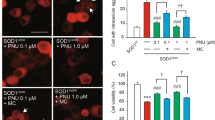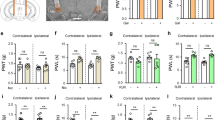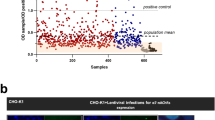Abstract
Aim:
To evaluate the anti-effects of anisodamine and neostigmine in animal models of endotoxic and hemorrhagic shock.
Methods:
Kunming mice were injected with lipopolysaccharide (LPS 30 mg/kg, ip) to induce endotoxic shock. Anisodamine (12.5, 25, and 50 mg/kg, ip) and neostigmine (12.5, 25, and 50 μg/kg, ip) were administered immediately after LPS injection. Survival rate was monitored, and the serum levels of TNF-α and IL-1β were analyzed using ELISA assays. The effects of anisodamine and neostigmine were also examined in α7 nicotinic acetylcholine receptor (α7 nAChR) knockout mice with endotoxic shock and in Beagle dogs with hemorrhagic shock.
Results:
In mice with experimental endotoxemia, combined administration of anisodamine and neostigmine significantly increased the survival rate and decreased the serum levels of inflammatory cytokines, as compared to those produced by either drug alone. The anti-shock effect of combined anisodamine and neostigmine was abolished in α7 nAChR knockout mice. On the other hand, intravenous injection of the combined anisodamine and neostigmine, or the selective α7 nAChR agonist PNU282987 exerted similar anti-shock effects in dogs with hemorrhagic shock.
Conclusion:
The results demonstrate that combined administration of anisodamine and neostigmine produces significant anti-shock effects, which involves activation of α7 nAChRs.
Similar content being viewed by others
Log in or create a free account to read this content
Gain free access to this article, as well as selected content from this journal and more on nature.com
or
References
Poupko JM, Baskin SI, Moore E . The pharmacological properties of anisodamine. J Appl Toxicol 2007; 27: 116–21.
Wang ST, Kuo NL . Experience in emergency treatment of shock due to infection. Chin Med J 1978; 6: 497–500.
Xiu RJ . Studies on microcirculation in the Institute of Basic Medical Sciences, Chinese Academy of Medical Sciences. Microvasc Res 1980; 20: 371–3.
Varma DR, Yue TL . Adrenoceptor blocking properties of atropine-like agents anisodamine and anisodine on brain and cardiovascular tissues of rats. Br J Pharmacol 1986; 87: 587–94.
Zhang WW, Song MK, Cui YY, Wang H, Zhu L, Niu YY, et al. Differential neuropsychopharmacological influences of naturally occurring tropane alkaloids anisodamine versus scopolamine. Neurosci Lett 2008; 443: 241–5.
Liu C, Shen FM, Le YY, Kong Y, Liu X, Cai GJ, et al. Antishock effect of anisodamine involves a novel pathway for activating alpha7 nicotinic acetylcholine receptor. Crit Care Med 2009; 37: 634–41.
Borovikova LV, Ivanova S, Zhang M, Yang H, Botchkina GI, Watkins LR, et al. Vagus nerve stimulation attenuates the systemic inflammatory response to endotoxin. Nature 2000; 405: 458–62.
Wang H, Yu M, Ochani M, Amella CA, Tanovic M, Susarla S, et al. Nicotinic acetylcholine receptor alpha7 subunit is an essential regulator of inflammation. Nature 2003; 421: 384–8.
Tattevin P, Monnier D, Tribut O, Dulong J, Bescher N, Mourcin F, et al. Enhanced indoleamine 2,3-dioxygenase activity in patients with severe sepsis and septic shock. J Infect Dis 2010; 201: 956–66.
Lavoie PM, Huang Q, Jolette E, Whalen M, Nuyt AM, Audibert F, et al. Profound lack of interleukin (IL)-12/IL-23p40 in neonates born early in gestation is associated with an increased risk of sepsis. J Infect Dis 2010; 202: 1754–63.
Zhang XH, Lei H, Liu AJ, Zou YX, Shen FM, Su DF . Increased oxidative stress is responsible for severer cerebral infarction in stroke-prone spontaneously hypertensive rats. CNS Neurosci Ther 2011; 17: 590–8.
Wang H, Liao H, Ochani M, Justiniani M, Lin X, Yang L, et al. Cholinergic agonists inhibit HMGB1 release and improve survival in experimental sepsis. Nat Med 2004; 10: 1216–21.
Guarini S, Altavilla D, Cainazzo MM, Giuliani D, Bigiani A, Marini H, et al. Efferent vagal fiber stimulation blunts nuclear factor-kappa B activation and protects against hypovolemic hemorrhagic shock. Circulation 2003; 107: 1189–94.
Bruegger D, Kemming GI, Jacob M, Meisner FG, Wojtczyk CJ, Packert KB, et al. Causes of metabolic acidosis in canine hemorrhagic shock: role of unmeasured ions. Crit Care 2007; 11: R130.
Liu C, Zhang GF, Song SW, Cai GJ, Liu WH, Miao CY, et al. Effects of ketanserin on endotoxic shock and baroreflex function in rodents. J Infect Dis 2011; 204: 1605–12.
Bernik TR, Friedman SG, Ochani M, DiRaimo R, Ulloa L, Yang H, et al. Pharmacological stimulation of the cholinergic antiinflammatory pathway. J Exp Med 2002; 195: 781–8.
Li M, Zheng C, Sato T, Kawada T, Sugimachi M, Sunagawa K . Vagal nerve stimulation markedly improves long-term survival after chronic heart failure in rats. Circulation 2004; 109: 120–4.
Pavlov VA, Ochani M, Yang LH, Gallowitsch-Puerta M, Ochani K, Lin X, et al. Selective alpha7-nicotinic acetylcholine receptor agonist GTS-21 improves survival in murine endotoxemia and severe sepsis. Crit Care Med 2007; 35: 1139–44.
Van Westerloo DJ, Giebelen IA, Florquin S, Bruno MJ, Larosa GJ, Ulloa L, et al. The vagus nerve and nicotinic receptors modulate experimental pancreatitis severity in mice. Gastroenterology 2006; 130: 1822–30.
Martin LF, Kem WR, Freedman R . Alpha-7 nicotinic receptor agonists: potential new candidates for the treatment of schizophrenia. Psychopharmacology 2004; 174: 54–64.
Hofer S, Eisenbach C, Lukic IK, Schneider L, Bode K, Brueckmann M, et al. Pharmacologic cholinesterase inhibition improves survival in experimental sepsis. Crit Care Med 2008; 36: 404–8.
Mathis KW, Sulzer J, Molina PE . Systemic administration of a centrally acting acetylcholinesterase inhibitor improves outcome from hemorrhagic shock during acute alcohol intoxication. Shock 2010; 34: 162–8.
Pavlov VA, Parrish WR, Rosas-Ballina M, Ochani M, Puerta M, Ochani K, et al. Brain acetylcholinesterase activity controls systemic cytokine levels through the cholinergic anti-inflammatory pathway. Brain Behav Immun 2009; 23: 41–5.
Dellinger RP, Carlet JM, Masur H, Gerlach H, Calandra T, Cohen J, et al. Surviving Sepsis Campaign guidelines for management of severe sepsis and septic shock. Crit Care Med 2004; 32: 858–72.
American college of chest physicians/society of critical care medicine consensus conference: definitions for sepsis and organ failure and guidelines for the use of innovative therapies in sepsis. Crit Care Med 1992; 20: 864–74.
Rivers EP, McIntyre L, Morro DC, Rivers KK . Early and innovative interventions for severe sepsis and septic shock: taking advantage of a window of opportunity. CMAJ 2005; 173: 1054–65.
Rivers E, Nguyen B, Havstad S, Ressler J, Muzzin A, Knoblich B, et al. Early goal-directed therapy in the treatment of severe sepsis and septic shock. N Engl J Med 2001; 345: 1368–77.
Lundberg JS, Perl TM, Wiblin T, Costigan MD, Dawson J, Nettleman MD, et al. Septic shock: an analysis of outcomes for patients with onset on hospital wards versus intensive care units. Crit Care Med 1998; 26: 1020–4.
Engoren M . The effect of prompt physician visits on intensive care unit mortality and cost. Crit Care Med 2005; 33: 727–32.
Blow O, Magliore L, Claridge JA, Butler K, Young JS . The golden hour and the silver day: detection and correction of occult hypoperfusion within 24 hours improves outcome from major trauma. J Trauma 1999; 47: 964–9.
Bledsoe BE . The Golden Hour: fact or fiction? Emerg Med Serv 2002; 31: 105.
Squadrito F, Altavilla D, Ioculano M, Calapai G, Zingarelli B, Saitta A, et al. Passive immunization with antibodies against tumor necrosis factor (TNF-α) protects from the lethality of splanchnic artery occlusion shock. Circ Shock 1992; 37: 236–44.
Guarini S, Cainazzo MM, Giuliani D, Mioni C, Altavilla D, Marini H, et al. Adrenocorticotropin reverses hemorrhagic shock in anesthetized rats through the rapid activation of a vagal anti-inflammatory pathway. Cardiovasc Res 2004; 63: 357–65.
Acknowledgements
This study was supported by the National Natural Science Foundation of China (30900529).
Author information
Authors and Affiliations
Corresponding authors
Rights and permissions
About this article
Cite this article
Sun, L., Zhang, Gf., Zhang, X. et al. Combined administration of anisodamine and neostigmine produces anti-shock effects: involvement of α7 nicotinic acetylcholine receptors. Acta Pharmacol Sin 33, 761–766 (2012). https://doi.org/10.1038/aps.2012.26
Received:
Accepted:
Published:
Issue date:
DOI: https://doi.org/10.1038/aps.2012.26
Keywords
This article is cited by
-
Neurotoxicity evoked by organophosphates and available countermeasures
Archives of Toxicology (2023)
-
Differential modulation of GABAA and NMDA receptors by α7-nicotinic receptor desensitization in cultured rat hippocampal neurons
Acta Pharmacologica Sinica (2016)
-
Combined administration of anisodamine and neostigmine rescued acute lethal crush syndrome through α7nAChR-dependent JAK2-STAT3 signaling
Scientific Reports (2016)
-
Comparative study on pharmacokinetics of a series of anticholinergics, atropine, anisodamine, anisodine, scopolamine and tiotropium in rats
European Journal of Drug Metabolism and Pharmacokinetics (2015)



